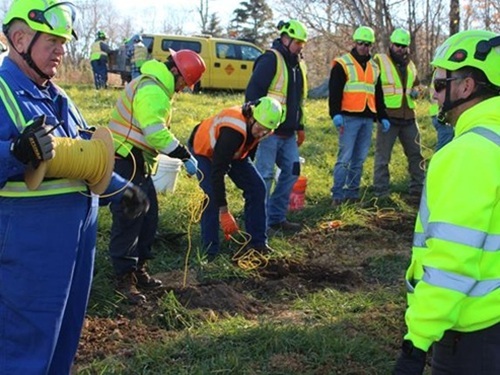The Iowa Department of Transportation recently provided an update on a research project that seeks to use technology to help snowplow operators “see” through the worst winter weather.
[Above photo by the Iowa DOT]
The agency – which is working with Iowa State University’s Institute for Transportation on this effort – has equipped a snowplow with sensors and driver aids to allow operators to continue working safely in low-visibility situations.
This technology doesn’t take over any control from the operator, but is designed to display critical information about where the plow is on the road and what obstacles may lie ahead, noted Jason Fisher with Iowa DOT’s Maintenance Bureau, in a blog post.

“When the visibility is low and it’s not safe for our operators to be out clearing snow, the snow piles up and it takes longer to get the roads open and get traffic moving again,” he explained. “If we can find a way to safely keep our plows on the road, even in low visibility conditions, that would make it possible to get the roads back in good shape quicker, helping travelers get where they need to go.”
But travelers aren’t the only concern when bad weather makes the roads treacherous. “When a bad storm is raging, emergency responders rely on us more than ever to keep the road passable so they can get to people who need assistance,” added Tina Greenfield, also with the agency’s Maintenance Bureau. “If we can keep our trucks on the road, we can better assist the emergency crews out there doing what they need to do.”
Rusty Martin, the garage operations assistant in Tama who wrote the initial proposal for the research project several years ago, explained in the blog post there are two parts to this effort, which is currently in “demonstration mode.” The first is a “navigation piece” that uses GPS-based data to help keep the plow operator on course, with the second an “object-avoidance piece” that uses data that alerts operators to what’s ahead of them on the road.
Over the past year, the truck equipped with the sensors has been collecting data, in all types of weather and while the operator is performing a variety of tasks. “During the planning stages, we looked for technologies that would do what we need them to do and were cost-effective,” Martin said. “Once we identified the technology and installed it last year, there has been a lot of tweaking. The test equipment we have set up is pretty simple and we’ll continue to collect data during this winter season.”
He stressed that keeping track of a road’s “paint lines” is the key for snowplow operators. “If you lose the paint lines, you have no idea where you are on the road,” Martin noted. “When we’re the first on a snow-covered road, it can be very difficult to visually see the paint lines. Training this equipment to ‘see’ the paint lines for the operator will make us clear the roads more effectively.”
While the team continues to hone the navigation piece of this research project, they will also be tweaking the sensors that detect obstacles hidden by snow. Martin said this phase of the project is proving to be a little trickier.
“What we are looking at would be something like the blind-spot alert system you might have in your personal vehicle,” he noted. “We are testing how well the system can detect stalled vehicles and other obstructions on the road. We’re not there yet, but I’m confident we’ll get there.”
 States
States
NCDOT Staff Participate in ‘Explosive’ Technical Training
December 19, 2025 States
States

